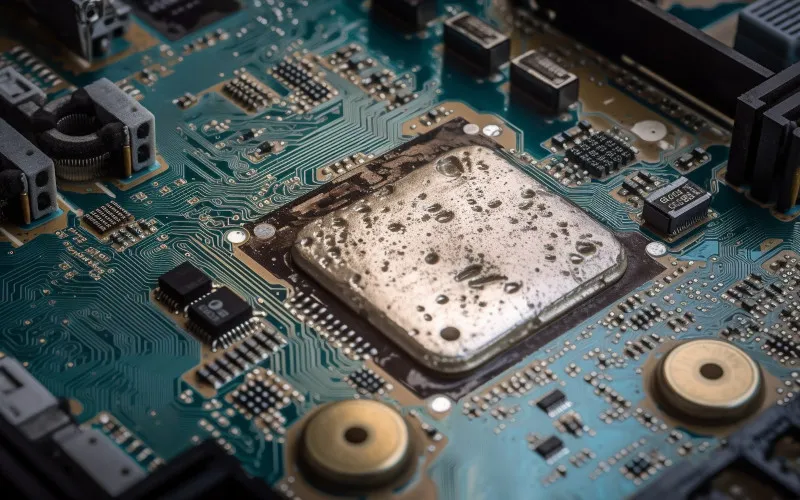As a computer enthusiast, I’m always interested in learning more about how to keep my devices running smoothly. One aspect of this that I’ve been curious about is thermal management, particularly thermal paste.
Thermal paste is a substance that helps to transfer heat away from a device’s CPU or GPU and onto a heatsink or other cooling solution. But can too much of this paste causes overheating instead of preventing it?
In this article, we’ll explore this question in more detail and see what the experts say. We’ll also discuss how much thermal paste you should use and offer tips for applying it properly.
So, if you want to optimize your device’s performance and avoid overheating, keep reading!
What is Thermal Paste?
Before diving into whether too much thermal paste can cause overheating, let’s first talk about thermal paste. Thermal paste, also known as a thermal compound, is a substance that’s used to fill microscopic gaps between a device’s CPU or GPU and its heatsink.
This paste helps improve heat transfer by filling in these gaps and ensuring heat is conducted away from the device more efficiently.
Thermal paste comes in various forms, including silicone-based, ceramic-based, and metal-based. Each type of thermal paste has different properties and is designed for use in different applications. Some thermal pastes also contain particles, such as silver or diamond, which can improve thermal conductivity.
Thermal paste plays an important role in keeping electronic devices cool and preventing overheating. But using too much thermal paste can have the opposite effect, which we’ll discuss in the next section.
Can Too Much Thermal Paste Cause Overheating?
Now, let’s answer the question that brought us here: can use too much thermal paste cause overheating instead of preventing it? The short answer is yes, it can.
While thermal paste is important for filling in gaps and improving heat transfer, too much can insulate the device’s CPU or GPU rather than conduct heat away from it. This can create an insulating barrier that prevents heat from transferring to the heatsink or other cooling solution, causing the device to overheat.
Additionally, using too much thermal paste can create a mess, as the excess paste can spill over onto other components and cause them to malfunction. This is why it’s important to use the correct amount of thermal paste for your specific device and application.
So, if you’re experiencing overheating issues, it’s worth checking the amount of thermal paste you’re using to ensure you’re not using too much of it. In the next section, we’ll discuss how much thermal paste you should be used for different applications.
How Much Thermal Paste Should You Use?
Now that we know that using too much thermal paste can cause overheating let’s talk about how much thermal paste you should use for your device.
The recommended amount of thermal paste varies depending on the size of the device and the specific application. Generally, a pea-sized amount of thermal paste is sufficient for most applications. This amount should be placed in the center of the CPU or GPU and spread evenly over the surface using a plastic applicator or another non-conductive tool.
It’s important to note that more thermal paste does not necessarily mean better cooling performance. As discussed earlier, using too much thermal paste can have the opposite effect.
If you’re unsure about how much thermal paste to use for your specific device, it’s always a good idea to consult the manufacturer’s recommendations or seek advice from a professional. In general, it’s better to err on the side of caution and use a conservative amount of thermal paste rather than risking overheating by using too much.
In addition to using the correct amount of thermal paste, it’s also essential to apply it correctly. In the next section, we’ll offer some tips for applying thermal paste effectively.
Tips for Applying Thermal Paste Effectively
- Clean the surface: Before applying thermal paste, it’s important to clean the surface of the CPU or GPU thoroughly to remove any existing thermal paste, dirt, or debris. Use a lint-free cloth and some isopropyl alcohol to clean the surface and ensure it’s contaminant-free.
- Use the right amount: As we discussed earlier, using too much thermal paste can cause overheating, so it’s important to use the right amount. A pea-sized amount of thermal paste is generally sufficient for most applications.
- Spread it evenly: Once you’ve applied the thermal paste to the center of the CPU or GPU, use a plastic applicator or another non-conductive tool to spread it evenly over the surface. Ensure the paste is spread in a thin, even layer to ensure optimal heat transfer.
- Don’t use too much pressure: When spreading the thermal paste, be careful not to apply too much pressure, which can cause the paste to spread too thin and reduce its effectiveness. Use light, even pressure to spread the paste over the surface.
- Check for air bubbles: After applying the thermal paste, check for any air bubbles that may have formed. If you see any, use a plastic applicator or another non-conductive tool to gently push the paste into the gaps and remove the air bubbles.
By following these tips, you can help ensure that your thermal paste is applied effectively and that your device runs cool and performs at its best. Remember, thermal paste is an important component of your device’s thermal management system, so it’s worth applying it properly.
Conclusion
Thermal paste is an important component of a device’s thermal management system, but using too much of it can cause overheating instead of preventing it. It’s important to use the correct amount of thermal paste for your specific device and application to ensure optimal cooling performance.
A pea-sized amount of thermal paste is generally sufficient for most applications. Still, it’s always a good idea to consult the manufacturer’s recommendations or seek advice from a professional if you’re unsure. It’s also important to apply thermal paste properly, spreading it evenly over the CPU’s or GPU’s surface using a plastic applicator or another non-conductive tool.
By using the correct amount of thermal paste and applying it properly, you can help ensure that your device runs smoothly and avoids overheating issues. So, if you’re experiencing overheating problems, check your thermal paste application and adjust it as needed.
With a little care and attention, you can help keep your device running cool and performing at its best.






